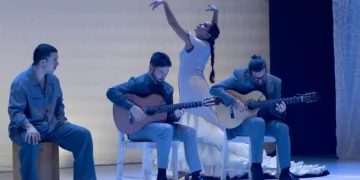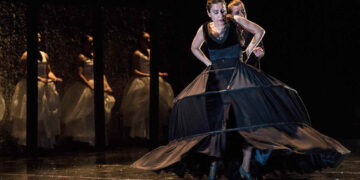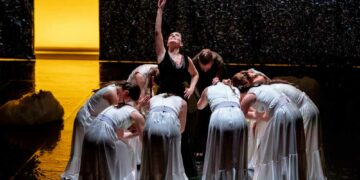|
|
|
SPECIAL COVERAGE: BIENAL DE FLAMENCO DE SEVILLA 2010 “150 GRAMOS DE PENSAMIENTOS” Rafaela Carrasco The Chef: Antonio Campos. The Helper: David Coria. The Utensils: José Luis López, Juan Antonio Suárez Cano, Jesús Torres. The Main Ingredient: Rafaela Carrasco. Alegrías choreography: Manuel Liñán. Last night at the Teatro Central we attended another debut under the auspices of the Bienal de Flamenco de Sevilla. Dancer Rafaela Carrasco presented her creation “150 Gramos de Pensamientos”. From what I’d read in the press release, I was expecting there to be explicit culinary references (cooking is my second obsession) as we saw so spectacularly presented in the work “Doña Flor and her two husbands” in the early nineties, with actual recipes included on the program and real food prepared on stage by the artists, but Rafaela’s gastronomic references were more abstract and indirect, things like chef’s hats, tables, bowls and some referential verses.
A lot of very positive adjectives could be applied to the always original work of Rafaela Carrasco, she is clearly an interesting woman with ample creative capacity. But no matter how hard I try, no matter how many ruffled dresses, fans, shawls or castanets she uses, no matter how much footwork and regardless of the high level of the singers and guitarists she surrounds herself with, I’m unable to call her artistic output “flamenco” without crossing my fingers behind my back. And I’m not sure why, except in the most general terms. Her dancing does not broadcast a flamenco feeling, and for this reason it only seems fair to judge her work as contemporary dance (excellent) and theater (superb). (The incessant tapping of feet is annoying). As in other works we’ve seen in this Bienal, there is some playful though brief role-changing when the singer plays the guitar or the dancer sings. There is also a cellist who does a fine job accompanying Rafaela in farruca. The transitions and theatrical tricks such as changing costume or rearranging props in full view of the audience seemed natural, well-organized and entertaining, and the artist not only allows but encourages a relaxed atmosphere among group members without that meaning there was any lack of discipline. (The tappity-tap-tap of feet doesn’t let up). There were some serious problems with the amplification. Bulerías without cante had you wondering the whole time when the voice was going to kick in. (And the incessant tapping is really becoming irritating). Antonio Campos is noteworthy as singer and actor, effortlessly managing tasks a classic singer is not normally required to do, and singing oddities like Lole’s “Todo es de Color” from thirty years ago, or tanguillos without compás or guitar accompaniment, very entertaining, for David Coria’s dance.
The cantiñas with choreography by Manuel Liñán and danced by Rafaela in a white bata de cola, is the closest you get to a conventional dance in this work (here the footwork tic finds its natural outlet), and everything ends innocently enough with abandolao. In my opinion, the most noteworthy thing about this new show of Carrasco’s is she has, for the time being at least, given up that terrible depressing austerity that was the norm in former works, opting instead for light, color and a few smiles (although I’d reduce the footwork by about 90%). Oddly enough, I’ve never seen such an unconvinced audience for this dancer who has always had diehard fans, especially among foreigners. They must not have found her “good enough to eat” on this occasion.
|
Descubre más desde Revista DeFlamenco.com
Suscríbete y recibe las últimas entradas en tu correo electrónico.



























